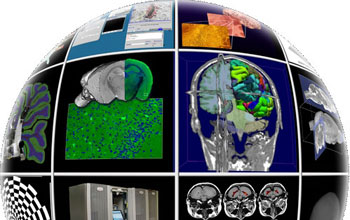News Release 04-075
Brain Disease Research, Particle Physics Meet in the Middle(Ware)
NSF Middleware Initiative proves key for grid-based collaborations in diverse disciplines

The Biomedical Informatics Research Network (BIRN) promotes advances in biomedical and health ...
May 26, 2004
This material is available primarily for archival purposes. Telephone numbers or other contact information may be out of date; please see current contact information at media contacts.
ARLINGTON, Va.—The study of Alzheimer's disease and the analysis of particle collisions may not appear to have much in common, but behind the scenes, middleware being developed with support from the National Science Foundation (NSF) is helping groups of researchers in neuroscience, physics and other fields to apply the power of grid-based computational resources.
Spanning 14 universities and 22 research groups, the growing Biomedical Informatics Research Network (BIRN) is establishing the cyberinfrastructure, or integrated information technology configuration, needed to facilitate health care research for large-scale data sharing and analysis. The ability to share and compare massive data sets such as MRI brain scans or high-resolution electron microscopy images is essential to participants' research into Alzheimer's disease, depression, schizophrenia, multiple sclerosis and other disorders.
With the participating research labs connected by the Internet2 high-performance network, the BIRN cyberinfrastructure uses software from the NSF Middleware Initiative (NMI) to harness grid-based services and resources for the demanding computational tasks of data mining, analysis and visualization. The BIRN is sponsored by the National Center for Research Resources at the National Institutes of Health.
"The BIRN has great promise to provide a collaborative working environment that promotes the growth of interdisciplinary science as well as an advanced biomedical cyberinfrastructure," said BIRN Coordinating Center Director Mark Ellisman. "The NMI middleware layer is essential to providing many of the underlying mechanisms critical to achieving this integrated environment."
By emphasizing open-source solutions that simplify resource sharing, NMI is making it easier for scientists, engineers and educators to work with colleagues on a worldwide scale through high-speed networks. The integrated tools from NMI facilitate collaborations across organizations, information technology architectures, operating systems and security policies.
Since 2002, NMI has issued twice-yearly releases of software, services and documentation supporting the effective use of information technology for research and education. Issued on May 24, NMI Release 5 (NMI-R5) consists of contributions from a wide range of middleware developers that partner through multi-institutional NMI-funded teams at the GRIDS Center, the EDIT consortium and the Open Grid Computing Environments consortium.
"Before NMI, many research communities were developing independent—and often incompatible—middleware solutions," said Kevin Thompson, NSF program director for NMI. "The successful use of the NMI releases by BIRN, Grid3 and other teams shows that NMI's open-source and open-standards approaches can help scientists avoid 'reinventing the wheel' and provide a common foundation for building customized applications."
Worlds away from neuroscience, the Grid3 project faces similar challenges in data management and computing requirements for particle physics and biological science. To conduct simulations of elementary particles that require massive amounts of data, the Grid3 collaborators, supported by both NSF and the Department of Energy, have deployed an international data grid spread across 28 sites in the United States and abroad and held together in part by NMI-supported software, such as the Globus Toolkit.
With assembled resources that provide up to 2,000 processors' worth of computational power, the Grid3 data grid runs seven different applications—three high-energy physics simulations and four data-analysis programs for high-energy physics, biochemistry, astrophysics and astronomy. The grid-enabled calculations simulate collisions of subatomic particles, biological interactions between molecules and protein sequences important to genome analysis.
Beyond grid computing, NMI middleware also enables many types of collaborative computing in the research and education community. Shibboleth, an NMI-EDIT software suite that manages user access to Web content and services while protecting privacy, has experienced worldwide adoption in addition to having widespread national impact.
Chosen by Australia, the Netherlands, and Finland and implemented in Switzerland as the basis for their national education federations, Shibboleth is also being adopted by the United Kingdom, which has made a significant commitment to standardize on the software. The U.K. Joint Information Systems Committee has begun work on building a national Shibboleth federation for the country's universities and colleges, alongside its current Athens access management system.
Established in late 2001, NMI funds the design, development, testing and deployment of middleware, key technologies upon which customized applications are built. Specialized NMI teams are defining open-source, open-architecture standards that are creating important new avenues of online collaboration and resource sharing. In addition to the production-quality software and implementation standards created by those large systems-integration teams, NMI funds smaller projects that focus on experimental middleware applications. As a leading part of the emerging cyberinfrastructure, NMI software and services are used by thousands of researchers and educators in the United States and beyond.
-NSF-
NSF Middleware Initiative: www.nsf-middleware.org
Grid3: www.ivdgl.org/grid2003
BIRN: www.nbirn.net
Media Contacts
David Hart, NSF, (703) 292-7737, email: dhart@nsf.gov
Program Contacts
Kevin Thompson, NSF, (703) 292-8962, email: kthompso@nsf.gov
The U.S. National Science Foundation propels the nation forward by advancing fundamental research in all fields of science and engineering. NSF supports research and people by providing facilities, instruments and funding to support their ingenuity and sustain the U.S. as a global leader in research and innovation. With a fiscal year 2023 budget of $9.5 billion, NSF funds reach all 50 states through grants to nearly 2,000 colleges, universities and institutions. Each year, NSF receives more than 40,000 competitive proposals and makes about 11,000 new awards. Those awards include support for cooperative research with industry, Arctic and Antarctic research and operations, and U.S. participation in international scientific efforts.
Connect with us online
NSF website: nsf.gov
NSF News: nsf.gov/news
For News Media: nsf.gov/news/newsroom
Statistics: nsf.gov/statistics/
Awards database: nsf.gov/awardsearch/
Follow us on social
Twitter: twitter.com/NSF
Facebook: facebook.com/US.NSF
Instagram: instagram.com/nsfgov


